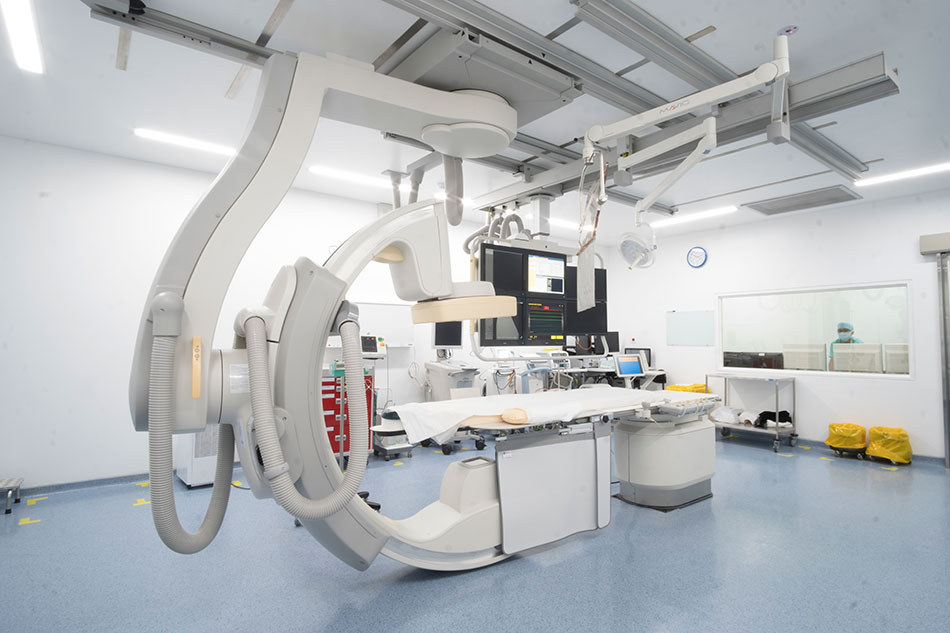Hypertrophic cardiomyopathy is a dangerous condition that can cause difficulty breathing and potentially lead to death. In the past, patients had to undergo major surgery for treatment. However, patients can now be cured through interventional cardiology, a procedure which takes about one hour and allows patients to be discharged within 48 hours.
Doctors save a 72-year-old patient with severe obstructive hypertrophic cardiomyopathy
Mrs Ngo Thi Kim (72 years old, from Binh Phuoc province) had experienced bouts of chest pain and difficulty breathing since 2018. She sought medical attention and was prescribed medication, but recently her shortness of breath and chest discomfort worsened, causing her extreme fatigue.
Doctors who examined her at several hospitals in Ho Chi Minh City stated that her case was challenging. Considering Mrs Kim’s deteriorating condition, they recommended she transfer to FV Hospital, which specialises in cardiology and is equipped with state-of-the-art facilities to perform advanced cardiac interventions.
When Ho Minh Tuan MD, MSc., Head of the Cardiology Department at FV Hospital, examined Mrs Kim he confirmed that she was suffering from severe obstructive hypertrophic cardiomyopathy with a blockage of up to 80 mmHg—a condition which made it difficult for her to breathe and was causing her heart to fail. Mrs Kim was also classified as severely obese (with a BMI of 35) and had high blood pressure. If left untreated, her condition could worsen, leading to pulmonary oedema and cardiac arrest.

Dr Ho Minh Tuan and the Cardiology team at FV Hospital perform a cardiac catheterisation procedure on the patient.
“The occurrence of hypertrophic obstructive cardiomyopathy is due to genetic mutations, causing the thickening of the heart septum and obstructing the blood flow. This is a difficult and dangerous condition, with numerous studies conducted worldwide, but it is still relatively new in Vietnam,” explained Dr Ho Minh Tuan.
In the past, the treatment approach required open-heart surgery to remove the thickened portion of tissue and alleviate the obstruction, which carried significant risks and complications. However, more recently. the minimally invasive technique of cardiac catheterisation, also known as percutaneous intervention, has been preferred by doctors to avoid the need for major surgery.

72-year-old Mrs Kim is filled with joy after receiving treatment for hypertrophic obstructive cardiomyopathy at FV Hospital.
Mrs Kim received a local anaesthetic and her doctor threaded a catheter through the blood vessels her arm and thigh. One route was used to place a temporary pacemaker, which would be removed after the procedure. The remaining route was used to introduce a special balloon device into the heart chamber. Once the blockage location was identified, the doctor injected biological alcohol, making the heart wall thinner and reducing the obstruction. As a result, the blood could flow freely and nourish the body without blockage, effectively improving the condition of heart failure. This procedure only took one hour. Importantly, the patient remained conscious during the procedure, and since there was no need for intubation, Mrs Kim could be discharged after 48 hours.
Two days after the intervention, Mrs. Kim reported a significant improvement in her condition. She expressed her gratitude, saying, “I feel so relieved now! No more chest discomfort, and my heart allows me to breathe normally again!” During her treatment at FV Hospital, Mrs Kim was deeply touched by the dedicated care provided by the doctors and nurses.
Hypertrophic cardiomyopathy: dangerous and difficult to detect.
Dr Tuan explains that hypertrophic cardiomyopathy is a difficult-to-detect and dangerous condition if left untreated. It is one of the causes of sudden death in athletes during competitions.
Hypertrophic cardiomyopathy presents with a range of symptoms, including shortness of breath, fainting (some individuals may experience multiple episodes) and chest pain. Some individuals may not exhibit any symptoms but have a family history of dilated cardiomyopathy, prompting them to proactively seek medical examination and monitoring. Patients suspected of being at risk of hypertrophic cardiomyopathy will undergo clinical examination followed by cardiac ultrasound, electrocardiogram, and CT or MRI scans of the heart. FV also offers genetic tests for screening and prevention of the disease.

Ho Minh Tuan MD, MSc., explains treatment methods for hypertrophic cardiomyopathy.
To comprehensively treat hypertrophic cardiomyopathy, the patient first needs to make lifestyle changes (moderate diet and exercise, avoid dehydration), take medication, and undergo intervention procedures when experiencing severe obstruction symptoms.
“Hypertrophic cardiomyopathy can be localised in certain areas of the heart chambers or the entire heart chambers may be affected. For patients diagnosed with heart failure due to obstruction in the left ventricle, intervening directly at that site will help improve the patient’s heart failure,” advised Dr Tuan.
Additionally, patients should undergo regular follow-up examinations or ultrasound scans once a year in cases of diagnosed dilated cardiomyopathy without obstruction or thickening of the heart wall.

FV Hospital is equipped with a modern catheterization laboratory (Cathlab) that can meet the demands of complex cardiovascular procedures.
Dr Tuan adds that trans-catheter intervention is a relatively rare procedure that can be performed by a limited number of medical facilities in Vietnam as it must be performed by experienced surgeons and technicians at specialist cardiovascular centre equipped with the necessary tools.
A specific type of balloon, usually sourced from oversees, is needed. FV Hospital is one of few cardiovascular centres to keep the special balloon readily available for emergency situations. Even in developed countries like the United States or Europe, only a few centres are able to offer this procedure.
FV has the unique advantage of a modern catheterisation laboratory (Cathlab) in which the hospital has invested heavily, providing ongoing training for its highly skilled team of doctors and ensuring comprehensive supplies and equipment for cardiovascular procedures.
Dr Ho Minh Tuan has performed approximately 50 interventions for the treatment of hypertrophic obstructive cardiomyopathy.
To learn more about the treatment of hypertrophic obstructive cardiomyopathy, please contact FV Hospital at the following phone number: (028) 5411 3333.



